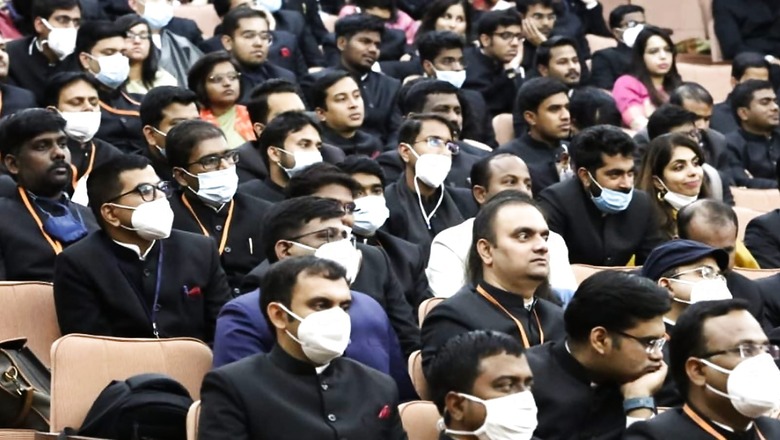
views
The year 2021 leaves an indelible mark on the future. From a governance perspective, 2022 should be the year for reforming government systems. Prime Minister Narendra Modi’s indefatigable energy has ensured that programmes and policies are implemented, but the system is still slow. Politicians are seen as external and temporary influence by bureaucrats, they see themselves as the system. Their apathy towards action and change is holding India back from achieving its potential as a $5-trillion economy. Without reforming the bureaucracy, it is unimaginable for India to reach its goals.
What defines the performance of a government system? Most would say the top level’s discipline as it ensures persistence in completing a task. But, at a systemic level, performance is about a system’s capacity to execute, not an individual’s persistence or ability. Unfortunately, meritocracy focuses on individuals, while systemic design cannot be based on individual brilliance.
Systemic focus needs training and building capacity at all levels, not hoping that the intelligent few on the top will ensure execution. Currently the focus of capacity building programmes in the government is on Class A employees. The remaining rungs of a system that employs more than 20 million people are not seen as important enough to train. The rules of the system are made by top echelon for the benefit of the top, so efforts around linking promotion to performance are resisted, and promotions are linked to tenure or period.
Moreover, power is centralised in a manner that hardly any initiative or decision can be taken by anyone else in the chain. This centralisation of decision-making demoralises the system, prevents delegation and results in delays. Delays in decision-making most often cause break down of the project. The system does not penalise delays nor does it recognise delays as systemic failure. This results in an attitude where time is endless and decisions are not considered time-sensitive.
When this attitude flows through the system, it leads to downstream delays, right down to the delivery of services from the government to the citizens. A drain that overflows in monsoon if inspected in summer will not show overflow. If the problem is not seen how will it get resolved? It is not lack of manpower that prevents delays or challenges in execution, it is poor system management and design.
Last-mile Execution Conundrum
Take last-mile execution at the level of the Deputy Commissioner (DC); this is where every policy, scheme or plan meets the execution crucible. This is where maximum resources are required. But this is where the capacity is most constrained. The IAS fraternity controls this level. All the departments that exist in the state government are managed at the district level by one man–the DC, who has to execute numerous schemes, plans and agendas. Whether it is the CM’s favourite scheme or the PM’s Beti Bachao, Beti Padhao, it is the DC who has to execute it.
Say, the state government has launched a new scheme for landless labour. It will hold a meeting of all the DCs to roll out this scheme. But the reverse will not happen. A formal feedback mechanism of what is working or not working will not be part of the review mechanism of any scheme. It is top down approach. If an enthusiastic DC does provide feedback s/he is quickly patted down as the meritocracy does not ever want to admit that it doesn’t know something or overlooked the obvious.
This is the biggest systemic challenge: the inability to take feedback in a positive manner or to make a change based on feedback from the ground. Somehow the most intelligent student in the class is not willing to admit in that there are things they do not know! This non-admission leads to systemic blind spots and bad policy designs. A poorly designed target for a policy ends up frittering away sources.
Take the Farmer Producer Organisation (FPOs). These organisations are being pushed as an answer to the lack of any corporate structure in rural India. Almost every agricultural scheme that is to be delivered in the rural areas has higher benefits for FPOs. A farmer wanting to take advantage of horticulture, agriculture, warehousing scheme in say Haryana is obligated to go through an FPO to get the full benefits. National Bank for Agriculture and Rural Development or NABARD sets targets for every district to set up new FPOs every year. The number of FPO registrations keeps increasing each year but nobody investigates how many of these FPOs actually transact any business after the first year of registration.
There is obviously a faulty design; the focus should not be on the number of FPOs registered every year but on the value of business conducted through FPOs. Schemes utilised by the FPOs, benefits or infrastructure created by the FPOs should be the focus. Nine out of 10 FPOs go dormant within a year. Mostly due to lack of direction, narrow management bandwidth, or internal conflict on issues. But the lie keeps getting bigger every year, as NGOs, bankers and consultants keep getting “awarded” for starting new FPOs. It is similar to recording the number of companies registered as a measure of economic growth instead of revenues generated or profits made or people employed.
At the DC level the number of departments reporting or dependent on the officer has to be reduced. ADCs have to be empowered to take direct control of departments, state services officers have to be promoted to take up the some of the departments so that they can bring their experience to bear on this important post. Training and development are crucial at this level for improving efficacy of the system. DC office itself has to be strengthened like a CEO or a CM office with support and management staff so that decisions can be monitored better. The most important last mile is the weakest in terms of support staff.
Let’s look at this challenge of feedback and performance at a system level.
ALSO READ | Mohandas Pai Writes: Technocrats as Ministers Can Help PM Modi Deliver Better on Jobs
Feedback to Performance
Feedback is not sought on the impact of a scheme or policy because performance is rarely judged on the basis of real metrics. Typically, a scheme’s performance is judged on whether or not funds allocated to it are disbursed, not whether it has reached the right beneficiaries or used for the right beneficiaries.
Moreover, “performance” as a term is frowned upon by civil servants who choose a higher calling of service to the nation. As there’s is not a job but a service to the nation, they don’t want the usual performance metrics to apply to measure their impact. New-age companies are going in for 360-degree reviews for employees to get feedback from juniors, peers and seniors. The bureaucracy and even the judiciary want their appraisal to be secret, so much so that there are litigations if there’s even a lukewarm remark in the annual report.
Those who claim to be the country’s most competitive don’t want to compete on performance. They think performance is for animals or stage actors. This lack of an overview on performance means that there is never any feedback given on areas where the officer may lack a skill. For instance, there might be a case where the officer may not be good at dealing with people, or lacks leadership skills. This is often the case if the officer is an introvert and skill-specific training would help them build and motivate their subordinates. But this is hardly ever done.
Most DCs use WhatsApp to communicate or monitor the 40-50 departments that report to them. Such a large span of control means that a DC should rely on delegating decisions downward instead of trying to do everything themselves. But the rules of the system are such that every single decision even if taken by the subordinates has to be approved by a DC to make it happen.
As it is impossible for them to go through each and every decision, very often they are just blindly signing on hundreds of files, without reading even one of them. This “blind approval” without reading is a disservice to the process. Employees down the line do not do the due diligence as they do not have the responsibility. This lack of empowerment and responsibility combined with corruption can be a deadly mix for system failure.
And lack of responsibility combined with corruption means that the primary agenda can be sabotaged and public funds can be diverted for personal gains. If this happens under the patronage of politicians then it can lead to a system collapse. And the system does collapse frequently at various levels when it stops delivering.
Narendra Modi since his days as chief minister has been following a system of monitoring and managing every single project and file. This system involved both tracking performance and non-performance of every file or project. It involved a quick negative marking on officers’ ACR (annual confidential report) if the delay was intentional or persistent—it worked in Gujarat. Several other states built a similar system that Narendra Modi pioneered. It has been adapted and adopted over the last seven years at the PMO level. While the core philosophy of monitoring execution and delays remains the same, several other layers of management are necessary for things to move from the Centre to the district–this is where a systemic reform is needed. Several policies and schemes need to deliver with far greater efficacy.
Individual intervention cannot be the basis for driving system change; capacity has to be improved at all levels and transfers and promotions have to be linked to skills or expertise.
Capacity and Expertise Need Expansion
Decisions are power, and power is never given up, it is taken away. There are states where one IAS officer heads four to five departments, it’s impossible to do justice to more than one department at a time. But the power equation is decided on the basis of size of the budget under control, so more departments means more power. This practice has to be banned across states, and one officer should not head more than one department. If a department is not relevant like printing and stationary, it needs to be abolished, not used as a punishment posting. Large and important departments like finance or home in large states need multiple heads to reduce the span of control. The same logic applies at the Centre too.
Indifference creeps in government employees because there is no incentive for even a superlative performance. The system frowns upon recognising efforts publicly under an outdated sense that a public servant should not be seen as hankering after recognition or rewards. This outlook is outdated when even a coffee shop puts up pictures for employee of the month.
The Prime Minister wants karmachari to become karmayogi, and this needs a high level of motivation and it is only possible with a better incentive system. The karmayogis need to be recognised and celebrated as exemplars publicly not privately, with better postings or promotions.
India’s economy is on a recovery path and schemes like PLIs (production-linked incentives) and a better environment for business are expected to push it further. If bureaucratic reforms are implemented in a calibrated manner this growth will be sustainable.
The author is CEO, Center for Innovation in Public Policy. The views expressed in this article are those of the author and do not represent the stand of this publication.
Read all the Latest Opinions here




















Comments
0 comment